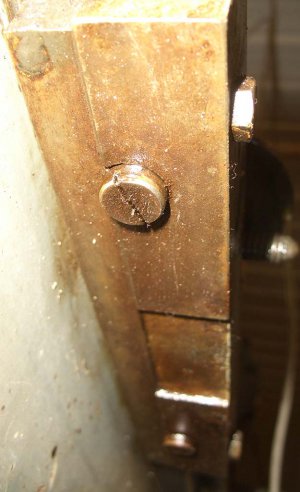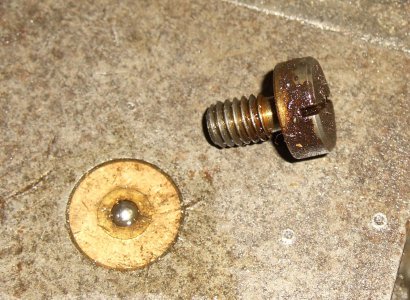-
Welcome back Guest! Did you know you can mentor other members here at H-M? If not, please check out our Relaunch of Hobby Machinist Mentoring Program!
You are using an out of date browser. It may not display this or other websites correctly.
You should upgrade or use an alternative browser.
You should upgrade or use an alternative browser.
Clausing 5418 Lathe
- Thread starter Rick_B
- Start date
Thanks Bruce - another case of a picture being worth a thousand words  I ws going toask how it actually worked but decided to do a bit more looking. what I didn't nderstand before is that the screw hole in the saddle is counterobred to accept the head of the screw. With the head overlapping the gib it is actually provifing an adjustment point for the gib to bed fit. I didn't see that because I had the horizontal locking bolts tightened before I put in the adjustment screws so the gob didn't move. It appears there is enough clearance in the saddle holes for the locking bols to allow the gib to move up and down a bit against the saddle.
I ws going toask how it actually worked but decided to do a bit more looking. what I didn't nderstand before is that the screw hole in the saddle is counterobred to accept the head of the screw. With the head overlapping the gib it is actually provifing an adjustment point for the gib to bed fit. I didn't see that because I had the horizontal locking bolts tightened before I put in the adjustment screws so the gob didn't move. It appears there is enough clearance in the saddle holes for the locking bols to allow the gib to move up and down a bit against the saddle.
Did you happen to notice of you had a shim between the gib and saddle? The parts drawing doesn't show one and I didn't have one when I disassembled. I haven't actually checked yet if I can get the gib adjusted against the bed and still get the locking bolts installed. I may need to add some shims between the gib and bed.
Rick
Did you happen to notice of you had a shim between the gib and saddle? The parts drawing doesn't show one and I didn't have one when I disassembled. I haven't actually checked yet if I can get the gib adjusted against the bed and still get the locking bolts installed. I may need to add some shims between the gib and bed.
Rick
- Joined
- Dec 25, 2011
- Messages
- 10,510
The manual for Rick's machine shows lubing the back gears with the plugged hole between the gears on the bench models. On the cabinet under drive models, it shows the ball oiler in the right end of the back gear spindle. There are two separate lubrication charts for the two versions.
The purpose of the hold down plates is to keep the carriage from being lifted off of the bed and V-rail. If the factory didn't install shims there, they must have considered the running clearance as not critical so long as it was a positive number and assumed that the weight of the carriage assembly was sufficient under normal circumstances.
The purpose of the hold down plates is to keep the carriage from being lifted off of the bed and V-rail. If the factory didn't install shims there, they must have considered the running clearance as not critical so long as it was a positive number and assumed that the weight of the carriage assembly was sufficient under normal circumstances.
The manual for Rick's machine shows lubing the back gears with the plugged hole between the gears on the bench models. On the cabinet under drive models, it shows the ball oiler in the right end of the back gear spindle. There are two separate lubrication charts for the two versions.
The purpose of the hold down plates is to keep the carriage from being lifted off of the bed and V-rail. If the factory didn't install shims there, they must have considered the running clearance as not critical so long as it was a positive number and assumed that the weight of the carriage assembly was sufficient under normal circumstances.
Robert - just for clarity - my machine is a cabinet model with underdirve that didn't have an oiler in the inboard eccentric (It does now
Thanks for the info regarding the saddle back gib.
Rick
Thanks to the infirmation upthread i now understand the purpose of the "cheese head screws" and their role in the gib adjustment process. I managed to get that adjustment done. I also got the 3 jaw chuck dialed in to .0015" run out. I've got another problem with the cross slide - it appears to have some movement front to bck when pushed manually. Not sure what's going on there but i suspect it has to do with the installation of the taper attahcment and the telescopic lead screw arrangement. More on that when I have an opportunity to take a closer look.
In the meantime I have a question regarding the QCTP. I have an AXA size o the lathe and it is a bit short for tool centering. The lathe came with a spacer block (1/4" I think) between the base of the post and the compound but that is only marginally acceptable in terms of height. I would like to put a 3/8 or 1/2 spacer in but am wondering about the advisability of using a spacer at all? Would a sacer impact the functionlity/stability of the QCTP? As much as I don't want to - should I be considering a BXA post?
Thanks
Rick
In the meantime I have a question regarding the QCTP. I have an AXA size o the lathe and it is a bit short for tool centering. The lathe came with a spacer block (1/4" I think) between the base of the post and the compound but that is only marginally acceptable in terms of height. I would like to put a 3/8 or 1/2 spacer in but am wondering about the advisability of using a spacer at all? Would a sacer impact the functionlity/stability of the QCTP? As much as I don't want to - should I be considering a BXA post?
Thanks
Rick
- Joined
- Dec 25, 2011
- Messages
- 10,510
Unless you have a zero-backlash cross feed nut under the cross slide, some movement of the carriage is to be expected. Just be sure that you have properly adjusted the cross feed screw end-float to as near zero as you care to tolerate.
So long as the spacer is the same shape as the bottom of the TP, I don't see why it would hurt anything. If the AXA is decent quality and you already have a good assortment of holders, I would certainly go with a spacer. I will say that it is unusual for an AXA to be too short on a 12".
So long as the spacer is the same shape as the bottom of the TP, I don't see why it would hurt anything. If the AXA is decent quality and you already have a good assortment of holders, I would certainly go with a spacer. I will say that it is unusual for an AXA to be too short on a 12".
Robert - I understand backlash is a given and probably more so with a telescopic taper attachment where there is a splinded lead screw. What I am experiencing is 1/8" movement in the cross slide (forward and back) when I pushnor pull the cross slide by hand. Thatdoesn't seem correct to me but maybe I am wrong?
Rick
Rick



